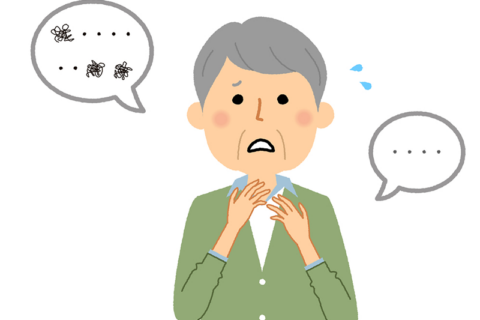Dysphagia Treatment: Five Easy Speech Therapy Exercises for Improved Swallowing

DISCLAIMER: The content in this article is for informational purposes only. The content on our website is not intended to be a substitute for professional medical advice, diagnosis, or treatment. Always seek the advice of your physician or other qualified health provider with any questions you may have regarding a health condition. Never disregard professional medical advice or delay in seeking it because of something you have read online! Please refer to our Terms of Use for complete details.
For many of us, eating is an activity that brings us considerable joy and is at the heart of many meaningful social connections. Getting together with friends and family to enjoy a meal is often an important daily ritual and marks many memorable life milestones.
Most of us have never paused to consider the complex and perfectly coordinated system of neurological and motor processes that underlie eating and swallowing. When someone experiences consistent difficulties with swallowing, this condition is known as dysphagia.
Dysphagia can be very disruptive to one’s life causing considerable discomfort, frustration, and anxiety around eating. Unfortunately, many people living with dysphagia report that these challenges pose significant negative impacts on their social and emotional well-being. For more details on the causes and symptoms of dysphagia see our blog: “Why Do I Cough When Drinking Water?”
If you or your loved one are having trouble swallowing and eating, we want to assure you that there are many ways to improve your comfort, confidence, safety, and enjoyment of meals.
Effective Speech Therapy for Dysphagia Treatment
Speech-language pathologists (SLPs) play a pivotal role in dysphagia treatment and management. They offer personalized interventions to improve swallowing function and prevent complications. In this guide, we’ll explore five easy speech therapy exercises designed to enhance swallowing safety and efficiency, drawing insights from evidence-based practices.
While dysphagia can certainly be alleviated and in some cases completely treated, we want to emphasize the importance of taking the condition seriously. Without appropriate dysphagia treatment led by a licensed speech-language pathologist or doctor, it can result in malnutrition, dehydration, and aspiration pneumonia. More often, it diminishes an individual’s quality of life and hinders their ability to participate in social gatherings centered around eating and drinking.
Exercise 1: Supraglottic Swallow
The supraglottic swallow is a technique aimed at protecting the airway during swallowing by closing the vocal folds before and during the swallow. To perform this exercise:
- Inhale deeply.
- Hold your breath tightly.
- Swallow while holding your breath and bearing down slightly.
- Exhale and cough immediately after swallowing to clear any residue and swallow again.
Repeat this exercise multiple times, gradually increasing the number of repetitions under the guidance of your speech-language pathologist.
Exercise 2: Mendelsohn Maneuver
The Mendelsohn maneuver focuses on increasing the duration and strength of the upward movement of the larynx during swallowing. This action improves the upper esophageal opening, the pharyngeal contraction, the pressure of tongue base contraction, and the speed of the overall swallow. Follow these steps:
- Place your fingertips lightly on your throat by the thyroid cartilage to feel the movement of your larynx.
- Swallow normally while paying attention to the upward movement of your larynx.
- Swallow again and when you feel the larynx elevate, hold it there with your fingers for several seconds.
- Gradually release the larynx and return to the resting position.
Practice the Mendelsohn maneuver regularly to enhance swallowing coordination and control.
Exercise 3: Effortful Swallow
The effortful swallow involves exerting deliberate pressure during swallowing to enhance the force and coordination of swallowing muscles. Here’s how to perform this exercise:
- Place a small amount of liquid or food in your mouth.
- With deliberate effort, swallow the liquid or food while squeezing your throat and neck muscles.
- Focus on generating as much pressure as possible during the swallow.
- Repeat the effortful swallow with various textures and volumes of liquids or foods.
Regular practice of the effortful swallow can strengthen swallowing muscles and improve swallowing efficiency helping to clear any residue left along the swallow tract.
Exercise 4: Masako Maneuver
The Masako maneuver targets the strength and coordination of tongue movements during swallowing to increase pharyngeal contraction. Follow these steps:
- Stick out your tongue and hold the tip of it between your teeth.
- Swallow while maintaining the tongue protrusion between your teeth.
- Focus on the sensation of the tongue pressing against the hard palate during the swallow.
- Gradually release the tongue-hold and return to the resting position.
Practice the Masako maneuver to improve the strength of pharyngeal contraction helping to propel food and liquid down the throat.
Exercise 5: Thermal Stimulation
Thermal stimulation involves applying cold or sour stimuli to the oral cavity to enhance sensory input and stimulate swallowing reflexes. Here’s how to incorporate thermal stimulation into your swallowing exercises:
- Use a cold or sour substance such as ice chips, sour candy, or a chilled spoon.
- Place the substance on different areas of your tongue and oral cavity.
- Allow the sensation to linger for a few seconds before initiating a swallow.
- Observe any changes in swallowing efficiency or sensation.
Consult with your speech-language pathologist to determine the appropriate type and intensity of thermal stimulation for your individual needs.
Following a consistent dysphagia treatment plan guided by the support of a licensed speech therapist will help you meet your goals for easy, safe swallowing, helping you to enjoy eating and drinking again! Adjustments to your treatment plan will be made along the way if they are needed to ensure you meet your established goals. Regular check-ups with your clinician are important to ensure the gains you make in therapy will be maintained.
Learn More About Our Services
Contact Open Lines® today by phone at 212-430-6800, by email at [email protected], or through our contact form. If you or a loved one are ready to take the next steps in managing your dysphagia, request an appointment to discuss your goals and review our service
Get in Touch With Open Lines®














